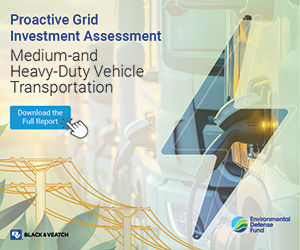Overcoming Today’s Challenges
Steve Hauser is CEO of the Association of Edison Illuminating Companies.
AEIC's members — which include large utilities, state and regional cooperatives, and municipalities — are responsible for delivering electric power when and where it's needed in the safest, most efficient, and cost-effective manner. Throughout any given year, this can be a challenge.

Utilities today must contend with an increasing number of storm events and environmental conditions, policy changes, critical grid modernization and investment projects, and an overall growth in demand for electricity that is sustainably generated at reasonable cost.
Now, add to this a global pandemic, significant supply chain disruptions, rising inflation, and a workforce shortage. The result is an unprecedented scenario that has forced utilities to respond in new ways to solve a wide range of concurrent challenges to keeping the lights on.
But the good news is that AEIC's members are problem solvers. They are highly capable of quickly rising to tackle whatever issues or obstacles threaten to disrupt service to their customers.
AEIC member, Southern Company, recently shared some of the strategic thinking and creative solutions their teams have developed to navigate through the myriad challenges currently faced by our industry.
Change as We Go Approach
As COVID-19 emerged as a global pandemic in early 2020, Southern Company, out of necessity, began shifting its traditional long-term strategy to a more real-time, "change as we go" approach for all aspects of supply chain management.
While the acquisition of materials and services has been harder on the power delivery side, the company is seeing challenges in acquiring basically everything needed to meet the day-to-day operational maintenance requirements of the grid, make important infrastructure upgrades, and proceed with large-scale capital investment projects.
This has required significant flexibility and responsiveness to acquiring essential raw materials and components, distributing materials to where they are needed most, addressing labor shortages, securing equipment for work crews, and managing rising costs.
Part of the effort has included almost real-time reprioritization of work schedules and projects based on whether or not all the resources needed are available and ready to go. Maintaining the system is job number one. Beyond that, there is a need to also ensure storm readiness which requires setting aside materials and separating them from normal inventory to ensure all benchmark levels of key materials and components needed to repair storm damage are in stock.
Then any infrastructure upgrades or capital investment projects are prioritized based on greatest need and whether there are sufficient resources to complete the project without impacting day-to-day operations or storm readiness.
"This can be a balancing act when you have a project that has been approved by the public service commission and you want to move it forward and complete it in a certain time frame," says Yvonne Essix, General Manager, Power Delivery Shared Services at Alabama Power. "Delaying investment projects might not impact the system today but it could create new challenges down the road."
Communication
Responding to supply chain issues has required much more frequent communication both internally across operational areas, as well as with manufacturers, suppliers, and business partners regarding all aspects of the supply chain.
The company now conducts weekly inventory review meetings to determine which materials are in greatest demand for each business unit. Even though the company has orders for materials in place — sometimes years in advance — many raw materials and components have been unavailable and backordered. Weekly calls are also held with suppliers to determine which materials are available and in what quantity.
Southern Company has also increased communications with business partners to keep them apprised of the current status of supply chain issues that might affect the work these partners have been contracted to perform.
"We've made sure they understand our position and what the market is doing, and that we understand their challenges too, so we can determine how that might impact our partners' ability to perform work for the company," said Coy Fredd, General Manager, Materials Management at Southern Company.
Materials Acquisition and Distribution
Shortages or unavailability of essential raw materials, parts, and components needed to maintain the grid has been widespread. The biggest area of concern for routine maintenance of the system has been transformers. The core steel used in the manufacture of transformers is scarce right now and utilities are competing to purchase any available supply.
To make matters worse, this same core steel is a key component in the rapidly increasing production of electric vehicles, creating more competition for this raw material. Compounding this issue is the fact that there is currently only one steel manufacturer in the U.S. producing this type of core steel. As a result, the industry is seeking relief from the U.S. Department of Energy to modify core steel requirements for transformers, which would allow for increased production.
In the meantime, Southern Company has been salvaging and returning to service previously used transformers that still meet operational specification requirements. The company has also reverted to using steel pole brackets (made from a different steel than transformers) due to the unavailability of the fiberglass used to manufacture the brackets the company had been using.
"We're going back and salvaging discontinued materials and determining what we can use and put back out in the system," said Fredd.
This has led to diversifying their approach to materials and components. Prior to COVID, the company had completed a full standardization of materials throughout its operations in Alabama, Georgia, and Mississippi. But as materials have become increasingly difficult to obtain in sufficient quantities, diversifying the approach to materials has helped get enough of the same type of parts and components even though they might not be from the same manufacturer or identical.
"We are now diversifying our product purchasing and going back to using materials we know will work even though they are not standardized across the system," said Lauren Lee, Manager, Category Management - Power Delivery Services and Materials at Southern Company.
Shortages of materials have also led Southern Company to develop new approaches for how these materials are stored and distributed. Normally, Southern Company would centralize the warehousing of materials and then distribute them to a single location for each operating unit.
Now, distribution of materials happens more point-to-point from one field location to another to make sure supplies get to where they are needed.
One example of this is that, due to longer lead times for shipments of wood poles, a key item needed for storm recovery, the company has begun ordering more frequently to keep more on-hand quantities. In addition, they have negotiated with suppliers to hold purchased storm stock at their facilities, so it is there when they need it.
Strengthening Partnerships
Supply chain challenges have led to stronger and expanded partnerships with manufacturers, suppliers, and contractors to address a wide range of issues affecting all sides.
Southern Company has worked to provide relief to its manufacturing partners by tying materials to a price index rather than a fixed pricing model.
"While this represents a short-term cost increase for us, it helps our manufacturers now when they need it, and will help us in the future by providing a mechanism to bring prices back down," says Lee.
The company is also working closely with its contractors to make sure that the work they were hired to do can get done. This includes recognizing resource availability and cost implications.
The job market is tight, so wages are higher despite the fact that the labor force, in many cases, is relatively new and inexperienced. In addition, it can be challenging to secure the heavy equipment needed for projects and the parts to repair them if they break down. Securing sufficient labor resources and working equipment as part of the contracting process is critical.
Fuel costs are also a concern.
"We value our contractors as partners and recognize that we need to solve these challenges together," says Kristen Bridges, Grid Investment Manager at Alabama Power. "They are an important extension of our institutional labor resources."
This is just a snapshot of some of the approaches one utility is taking to address challenges the entire industry is facing together. Some supply chain issues are expected to stabilize by the end of the year while others may take longer. How long exactly? No one can really say for sure.
The longer this continues, the more strain it will place on the grid and the people who operate and maintain it. We need a robust and sustainable supply chain and workforce to ensure sufficient, reliable supply of electricity to meet growing demand.
In other industries, supply chain challenges have resulted in product unavailability and drastically increased prices for consumers. Utilities, on the other hand, are doing an outstanding job of meeting their obligation to provide their product 24/7/365 without interruption and at a fixed rate.
"Fortunately, right now we are in pretty good shape," says Essix. "We've been able to handle additional load on our system because we've been able to collaborate with our partners and put strategies in place to ensure that consumers are not impacted. And we're starting to see some light at the end of the tunnel."
In addition to her duties at Southern Company, Yvonne Essix chairs AEIC's Electric Power Apparatus Committee where utilities from across the country can share best practices on these and other issues they face.




